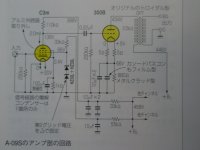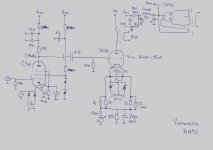Probably somewhat like this..
http://upload.review33.com/images/201002/201002141227448114.jpg
http://upload.review33.com/images/201002/201002141227448114.jpg
Reverse engineering this photo:
http://www.6moons.com/audioreviews/yamamoto6/2_open_big.jpg
http://www.6moons.com/audioreviews/yamamoto6/2_open_big.jpg
Attachments
C3M current
Guys
I have got to say that running the C3M at 2mA with a 110k load is an odd choice (typically Japanese DIY crazy "do something different"), given the capabilities of this tube. I have tried the opposite and ran 16mA into a 12k load, great sound and handles anything the 300b throws at it with ease. Still each to his own.
Guys
I have got to say that running the C3M at 2mA with a 110k load is an odd choice (typically Japanese DIY crazy "do something different"), given the capabilities of this tube. I have tried the opposite and ran 16mA into a 12k load, great sound and handles anything the 300b throws at it with ease. Still each to his own.
These were exactly my thoughts when looking at this schematic. With 2mA one could stay with the usual 6sl7 stuff, and the screen voltage is similar strange.
I used the same as you, 12k load with 16mA, 150V at the screen, and the 300B starts to rock, no ploddy bass anymore, balanced throughout the spectrum.
I used the same as you, 12k load with 16mA, 150V at the screen, and the 300B starts to rock, no ploddy bass anymore, balanced throughout the spectrum.
Guys
I have got to say that running the C3M at 2mA with a 110k load is an odd choice (typically Japanese DIY crazy "do something different"), given the capabilities of this tube. I have tried the opposite and ran 16mA into a 12k load, great sound and handles anything the 300b throws at it with ease. Still each to his own.
in pentode mode?
Yes in pentode. The C3M is a bad *** tube and is design for way more than 2mA. The 6.5W dissipation gives you a clue.
Regarding the screen voltage, you need to have a least the 300B bias voltage as a difference between the C3M's anode and screen. Typically the 300B has 75V bias so if you have 250V on the anode then the screen must be 250 - 75 = 175V. I seem to recall that Joseph Esmilla from Sound Practices fame (his website seems to have disappeared) recommended that the difference be 1.2 to 1.5 times the bias, so for our 250V anode this would give us a screen of 250 - 1.2*75 = 160V and 1.5 times gives 138V. I have mine at 150V. The important point is that the difference between anode and screen must be more than the output triode's bias.
To tweak the amp's harmonic profile, a pot in the screen divider would allow you to vary the screen voltage to achieve the best sound for your system. Once you figured out what screen voltage you like, then you can substitute the appropriate zener string. Remember in a two stage amplifier there is distortion cancellation and varying the screen varies the distortion profile when added to output triode's results in a particular sound. Hope this helps.
Regarding the screen voltage, you need to have a least the 300B bias voltage as a difference between the C3M's anode and screen. Typically the 300B has 75V bias so if you have 250V on the anode then the screen must be 250 - 75 = 175V. I seem to recall that Joseph Esmilla from Sound Practices fame (his website seems to have disappeared) recommended that the difference be 1.2 to 1.5 times the bias, so for our 250V anode this would give us a screen of 250 - 1.2*75 = 160V and 1.5 times gives 138V. I have mine at 150V. The important point is that the difference between anode and screen must be more than the output triode's bias.
To tweak the amp's harmonic profile, a pot in the screen divider would allow you to vary the screen voltage to achieve the best sound for your system. Once you figured out what screen voltage you like, then you can substitute the appropriate zener string. Remember in a two stage amplifier there is distortion cancellation and varying the screen varies the distortion profile when added to output triode's results in a particular sound. Hope this helps.
Correction
Sorry guys was trying to remember stuff from 5 years ago. I dug up some old notes about Joe Esmilla 6C6/2A3 single ended amp. A Russian named Sergey Didkovsky advised Joe to have the anode voltage twice the screen voltage: i.e. a 2:1 ratio. So for the 2A3 amp that Joe was building he had 152V on the anode and 76V on the screen of the 6C6. Interestingly, the 2A3 was biased at 52V, hence by my rule 1.2 to 1.5 times the bias to get the screen voltage, we get a range of 62 to 78V, which 76V is within range. The rule about anode to screen voltage difference being more than the output bias I think was Thorsten Loesch's. I just added the 1.2 to 1.5 factor as this gave a bit more swing from the driver and sounded better than a ratio of 1:1.
Whilst the two rules agree for the 6C6/2A3 example they do not for the C3M/300B. Maybe the 2:1 rule was for the 2A3 only, who knows. If it was me, I would ensure the swing from the driver first is adequate then adjust the screen to the best sound.
Sorry guys was trying to remember stuff from 5 years ago. I dug up some old notes about Joe Esmilla 6C6/2A3 single ended amp. A Russian named Sergey Didkovsky advised Joe to have the anode voltage twice the screen voltage: i.e. a 2:1 ratio. So for the 2A3 amp that Joe was building he had 152V on the anode and 76V on the screen of the 6C6. Interestingly, the 2A3 was biased at 52V, hence by my rule 1.2 to 1.5 times the bias to get the screen voltage, we get a range of 62 to 78V, which 76V is within range. The rule about anode to screen voltage difference being more than the output bias I think was Thorsten Loesch's. I just added the 1.2 to 1.5 factor as this gave a bit more swing from the driver and sounded better than a ratio of 1:1.
Whilst the two rules agree for the 6C6/2A3 example they do not for the C3M/300B. Maybe the 2:1 rule was for the 2A3 only, who knows. If it was me, I would ensure the swing from the driver first is adequate then adjust the screen to the best sound.
- Status
- This old topic is closed. If you want to reopen this topic, contact a moderator using the "Report Post" button.
- Home
- Amplifiers
- Tubes / Valves
- Yamamoto A-09s

